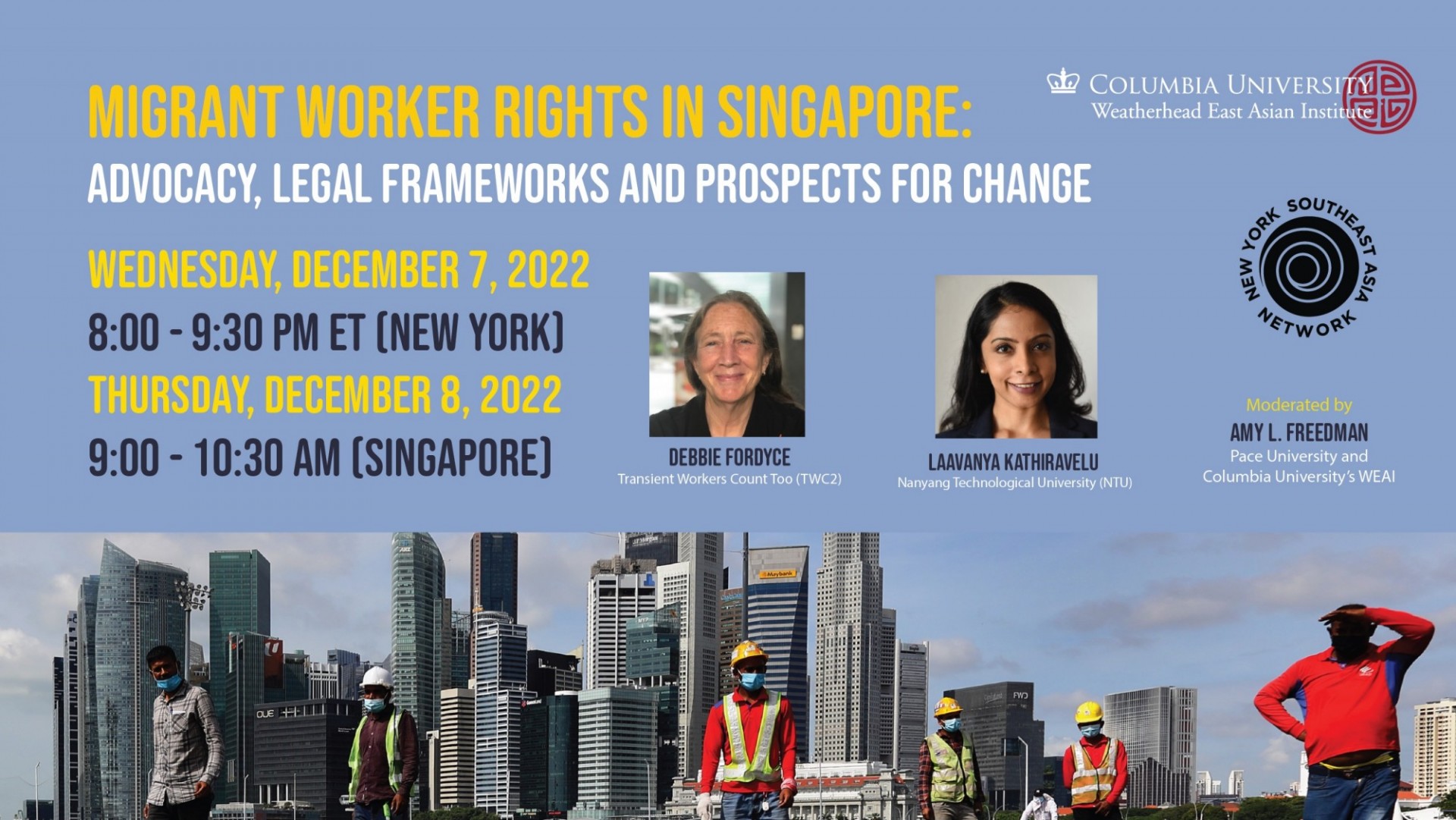Migrant Workers Rights in Singapore: Advocacy, Legal Frameworks and Prospects for Change

COVID-19 highlighted many structural problems faced by migrant workers in Singapore, including high recruitment costs, restricted job mobility, weak wage protection, and poor workers' safety. In a webinar held on December 7, 2022, entitled "Migrant Workers Rights in Singapore: Advocacy, Legal Frameworks and Prospects for Change," Debbie Fordyce, President of Transient Workers Council Too––a nonprofit organization advocating for more robust migrant labor policies in Singapore––laid out the structural regime and history of how migrants come to work in Singapore. Also speaking at the event, Laavanya Kathiravelu, Associate Professor at Nanyang Technological University, focused on the impact of COVID-19 and the everyday lives of migrant men as well as Singaporeans’ views on migrant workers. WEAI Research Scholars Amy L. Freedman and Ann Marie Murphy moderated the discussion.
A now-familiar pattern of migration that Fordyce describes as "circular migration" sees low-wage migrants move back and forth between their home and abroad. This creates a lifelong temporariness with no prospects of settling in the country where they work. The exploitative framework of the "kafala system," which ensures that migrant workers are beholden to their in-country visa sponsor, reinforces this pattern by preventing migrants from marrying the locals or bringing their families with them. Migrant workers are tied to a single employer–– often without a written contract––limiting job mobility while working under the constant threat of termination. They also contend with scams from companies and recruitment agents, which charge high recruitment fees for jobs that were never available to them. This migration pattern also responds to the labor shortage in wealthier countries where the locals are unwilling to engage in dirty manual work, and unemployment in developing countries is high. It gives rise to what Kathiravelu argues is a racialized or ethicized immigration regime. Using the data from The Ministry of Manpower, Kathiravelu shows that the Singaporean government receives low-wage workers from "source countries," with the most significant proportion coming from Bangladesh, India, and China, in addition to Sri Lanka, Thailand, the Philippines, and Vietnam.
Fordyce challenges the assumption that migration benefits the receiving and sending countries equally. Singaporean government-controlled media promote the notion of happy workers to reassure the public that Singapore provides adequate systems and safety nets for migrant workers. However, both Fordyce and Kathiravelu contradict this. They explain that low-wage migrant workers are segregated and excluded from the rest of Singaporean society, where they cannot access specific public spaces. Worse, Kathiravelu notes that many workers often come to internalize this ostracism, and feel they do not have equal access to public spaces either.
COVID-19 further exacerbated these disparities. The migrant workers' movement has been limited, especially during the pandemic when they were relegated to crowded dormitories, further turning them into an invisible class of people. In order to move about, workers also had to apply for passes to leave their dormitories. This resulted in the migrant workers bearing the brunt of the pandemic. Kathiravelu noted in her presentation that as of August 2021, low-wage migrants who live in dormitories accounted for 82.4% of COVID cases in Singapore, while citizens and permanent residents only accounted for 9.8%. It also gave rise to digital surveillance through apps that track their movement and symptoms. Migrants were forced to check their symptoms three times a day and made responsible for their health and well-being. This led to an increase in mental health issues among migrant workers that resulted in some committing suicide. In addition, many migrants were also forced to return to their home countries. This drove them into further debt as their source of income was cut off with little to no savings, leaving them unable to pay off the high recruitment fees or provide for themselves and their family.
While the pandemic exposed poor work conditions for migrant workers, it also increased awareness and could mobilize better efforts to protect migrant rights. Migrants have turned to social media to show their poor living conditions as a last resort when their employer or the state fails to respond to their needs, leading to public outcry. While this response is welcoming, both speakers warn that it is not a cause for celebration.
The event, "Migrant Workers Rights in Singapore: Advocacy, Legal Frameworks, and Prospects for Change," was sponsored by the Weatherhead East Asian Institute and the New York Southeast Asia Network. Learn more about the Weatherhead East Asian Institute's Asia in Action initiative here.
